full article:
Introduction
A significant proportion of Indigenous Australians live in rural communities1 and experience a greater burden of illness than do non-Indigenous people in the same communities2. Indigenous rural dwellers are more likely than non-Indigenous rural dwellers to be affected by rural risk factors, including reduced availability of appropriate local health services, the economic cost associated with accessing distant health services, and reduced access to transport 2. For Indigenous rural dwellers, cultural factors such as language difficulties and the attitudes of health professionals are additional barriers to obtaining health care1. There are many published reports about the poor general health status of Indigenous Australians1,3-5. Some reports suggest that Indigenous people who live in rural and remote communities endure conditions similar to those in the developing world6,7.
From the beginning of European settlement, Aboriginal people have been subject to influences such as 'protectionism' and 'assimilation' which have radically encroached on their culture and lifestyle with disastrous effects on their physical and psychological health. The dispossession, the destruction of hunting fields and ceremonial sites and the devastation of Indigenous lives are all related. The psychological trauma associated with disruption of family, social and cultural lives has left a generational legacy of despair, hopelessness, powerlessness and helplessness8.
People do not become ill or die simply because they are Aboriginal. Poor Aboriginal Health is traced to 200 years of oppression and limited opportunity following European settlement9.
There is scant evidence reporting the health of Indigenous Australians prior to contact with European people. Most of the evidence is pieced together from the descriptions of early European explorers10-12. The reports suggest that the traditional hunter-gatherer lifestyles of Aborigines provided their community with lifestyles which, prior to European contact, were '...enviable in terms of health, nutrition and leisure'5. Within traditional Indigenous communities, the hunter-gatherer lifestyle encouraged frequent exercise which minimised the risk of obesity and associated health conditions8.
Throughout the world, musculoskeletal health problems are a major morbidity issue for Indigenous populations13 and the social and economic burdens imposed by musculoskeletal complaints are significant13. Musculoskeletal conditions may involve all muscle and joint structures and commonly include low back pain, neck and shoulder pain, upper and lower extremity syndromes and degenerative conditions such as osteoarthritis14. Musculoskeletal conditions of 'mechanical' origin, that is, those that are associated with physical trauma or stress to the human frame, particularly those classified as chronic (of greater than 7 weeks' duration) are frequently associated with pain and disability15. These conditions are commonly characterised by symptoms of pain, tenderness, swelling or stiffness of joints or muscles15. Little research has been performed on the prevalence and associated pain and disability of musculoskeletal conditions among this most disadvantaged Australian population.
Previous studies
It has been estimated that approximately 30% of the Australian population experience musculoskeletal problems leading to acute pain and impairment14. Osteoarthritis was one of the most common musculoskeletal conditions among those aged 55 years or older, reported by 40% of Indigenous people and 45% of non-Indigenous people, in non-remote areas1. Prescribed analgesics (pain relievers) were the most commonly used medication among Indigenous (16%) and non-Indigenous people (24%) with their overall use increasing among both older age-groups of 55 years and older1.
Musculoskeletal conditions in rural and remote Indigenous Australian populations are complicated by the poor health suffered by this group13. Obesity, for example, is a risk factor for cardiovascular disease and diabetes. It may also predispose to low back pain and increased stress and pain in other weight bearing joints16. The disturbingly high psychological burden of illness imposed by the despair, anxiety and depression reported in Aboriginal communities8 may also predict episodes of back pain17,18. Moreover, the greater socio-economic disadvantage experienced by Indigenous Australians exerts a disadvantage across a range of health conditions14.
The limited number of studies examining musculoskeletal conditions among Indigenous Australians suggest a high burden of illness associated with these conditions. In 1993, Mayhew19, conducted a non-random pilot study of the Occupational Health and Safety status of 257 Indigenous Australians in Queensland. There was a greater proportion of 'diseases of the musculoskeletal system and connective tissue' among Indigenous interviewees compared with the general Australian population. Mayhew concluded, in part, that Indigenous people were exposed to greater manual handling occupational stresses. In 1998, another Australian study attempted to examine the prevalence and burden of illness attributable to musculoskeletal conditions among Indigenous Australians (community survey of 152 members of an outer eastern and rural fringe area of Melbourne)20. The study found that 14% of chronic conditions were reported to be diseases of the musculoskeletal system and these were more likely to be present among people 40 years and older. This was confirmed by a later study1. A cross-sectional survey of one Aboriginal community (n = 56) living in a semi-traditional setting examined the prevalence and cultural determinants of back pain21. Approximately one-third of men and half of the women reported the presence of long-term low back pain. Reports of a high rate of musculoskeletal conditions in rural Indigenous communities in countries other than Australia13 may also apply to rural Indigenous Australians.
Context
This article describes the results of a musculoskeletal prevalence study conducted in the Kempsey district, New South Wales, site of one of Australia's largest rural Indigenous communities. This Aboriginal community is located in the mid-north coast region in an area of 3335 km2 from the mountain headwaters of the Macleay river in the west, to the eastern coastal villages. The rural township of Kempsey, population 27 500, is the main service and commercial centre for the shire, providing shops, government services, schools, Tertiary And Further Education (TAFE), Adult Education, health services, Centrelink (the Social Security/ welfare centre) as well as Shire Offices, library and sporting facilities. The Macleay River divides eastern and southern portions of the town.
Indigenous population
The Aboriginal-controlled health services are Durri Aboriginal Corporation Medical Service (ACMS), Booroongen Djugun College (for training Aboriginal Health Workers, AHWs), and Booroongen Djugun hostel for elders. The Indigenous population of the area was approximately 55022.
The study
This study was conducted between January 2001 to July 2002 and aimed to identify the:
- Prevalence of musculoskeletal conditions
- Associated levels of pain (in various anatomical sites), and impairment in the community
- Treatments sought
- Barriers to the management of these conditions.
Ethics: consent and approval
Participating community members completed a consent form that explained the purpose of the survey. Ethics approval was obtained from the Durri (ACMS) Board of Directors and the Human Research Ethics Committee of the University of Newcastle.
Methods
Community consultation, collaboration and ownership of the program
Following discussions with a cross-section of community members, a Community Advisory Group (CAG) was formed (which included representatives from the Durri ACMS, Booroongen Djugun Aboriginal Health Worker College and the University of Newcastle. The CAG aimed to collaboratively develop a culturally appropriate musculoskeletal health training program for AHWs following this study23. Community consultation continued throughout the study, and this process involved regular discussions with key-informants from the community including AHWs, elders and health professionals. The community was informed of developments via information sheets and the publication of a summary report during the process and at the completion of the study.
Design and sample
Participants: Participants included 189 Indigenous community members. Of these, 80 were randomly selected using a stratified random sampling procedure with stratification on age and sex to derive a representative sample, and the remaining 109 were recruited for a convenience sample. Participants' mean age was 44 years (±14.8) and the median age was 43 years. There was no significant difference in the male and female ages (p = 0.348). The subjects' weight ranged from 55 kg to 175 kg with a mean of 88 kg (±21.9) and median of 85 kg. There was no significant difference between the weight of males and female participants (p = 0.861).
A cross-sectional research design was used. The sample, which included 87 males (46%) and 102 females (53%) ranging in age from 15 to 80 years, was selected from an estimated population of 550 persons aged 15 years or older who had been previously identified as Aboriginal (according to the definition of Aboriginal adopted by the Department of Aboriginal Affairs Constitutional Section23. Although the consent rate was high (85% for a randomly recruited sample), the final response rate was low (40%) because many members of this highly mobile community could not be contacted. To increase the sample size, a convenience sample was recruited from a local population, as suggested by the CAG.
Measures
The main outcome measures were:
- Self-reported levels of pain validated by clinical assessment
- Anatomical sites of current pain
- Pain limitation to activities of daily living (ADL)
- High levels of pain were interpreted as those ranging between 6 and 10 on a Likert scale of 0-10.
- Associated barriers to managing musculoskeletal symptoms.
Screening survey
Participants completed a previously validated screening survey24 which was administered by AHWs. The purpose of the screening survey was to identify participants who had experienced a musculoskeletal condition including ache, pain or discomfort. The survey also measured self-reported limitations to ADL imposed by pain. (Participants subsequently attended a clinical assessment to confirm the presence of musculoskeletal conditions. The assessment was performed by musculoskeletal health professionals and based on standard clinical assessment parameters24.) Data were entered on-site into a specifically designed, CAG approved, Microsoft Access database by health workers using a lap-top computer.
Analysis
Frequencies and Confidence Intervals were reported for demographic data, reported levels of pain, impairment and barriers to managing musculoskeletal conditions.
Results
The occupational demographics of the participants in the study are summarised (Table 1).
Table 1: Occupational demographics of the community sample
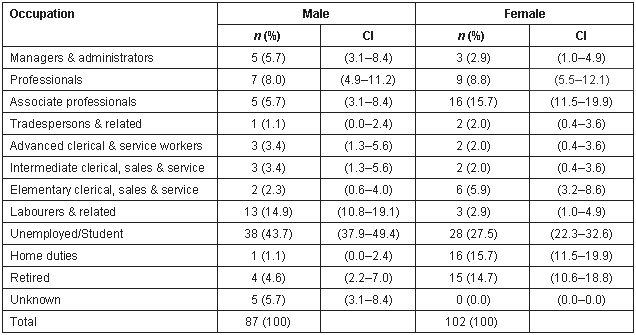
Musculoskeletal conditions were widely experienced in this Community. Most respondents 95% (95% CI: 92%-97%) reported that they had experienced pain in at least one main site in the 7 days prior to the study (Table 2). Lower back pain (LBP) was the most commonly reported musculoskeletal condition among both male and female participants at 39% (95% CI: 75%-86%).
Table 2: Prevalence of the main self-reported musculoskeletal conditions (ache, pain or discomfort) in the 7 days prior to the study, according to sex
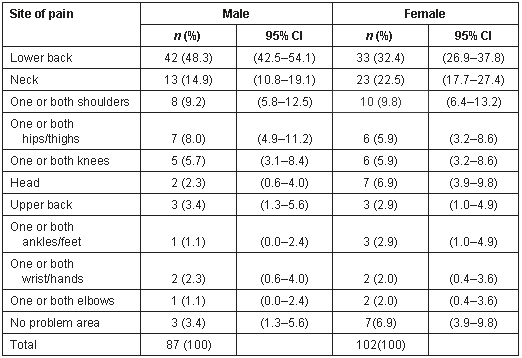
Number of reported musculoskeletal conditions
Data presented (Table 3) show that 87% of the participants reported multiple musculoskeletal conditions in the previous week. The majority of community members (64%) reported experiencing the main condition for 7 weeks or more (Table 4).
Table 3: Number of reported musculoskeletal conditions (ache, pain, discomfort) in the 7 days and 12 months prior to the study
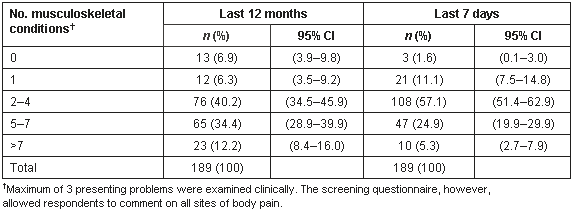
Table 4: Duration of the present episode of the participant's main condition

Pain and limitation
Participants rated their pain as relatively high compared with the associated levels of limitation (Fig 1). Of those surveyed, in the 7 days prior to the study, 68% (95% CI: 61%-74%) reported experiencing high levels of pain (ie between 7 and 10). The number of participants who said their symptoms significantly limited (ie rated between 7 and 10) their activities of daily living was 38% (95% CI: 31%-45%).
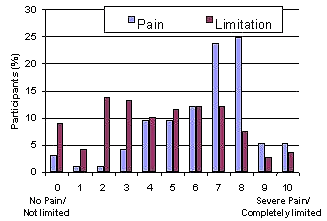
Figure 1: Reported level of pain and limitation in last 7 days (n = 189).
Figure 2 shows that of those surveyed, approximately 99 (52%) had obtained management or treatment for their current condition (Fig 2).
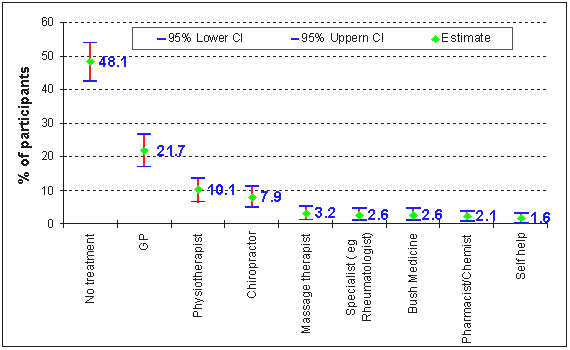
Figure 2: Management of musculoskeletal conditions.
Barriers to managing musculoskeletal conditions for rural Aboriginal Communities
Of the 52% (n = 99) who reported a musculoskeletal condition in the previous 7 days, 48% (n = 90) had not received treatment or management for the conditions because they: had "learned to live with" the problem (33%); were "unaware of what might help" (17%); or found "private therapies were too expensive (13.2%) (multiple reasons were allowed).
Discussion
This study suggests that the typical musculoskeletal profile of a Community member is that of a:

Limitations
Contact rates were low at 50%. Where contact was made, however, consent rates for participation in the study were high, approximating 85%. Over the one-year period in which the prevalence study took place, 80 participants (40% of those selected from the initial proportional random sampling strategy) were able to be assessed. Although this poor contact rate may compromise the ability to generalise the findings of this study, the limitation appeared unavoidable and itself highlights an issue intrinsic to rural and remote health research25. To supplement the process of recruiting community members, a convenience sample was also recruited. This strategy was informed by the experience of other researchers working in the area of Aboriginal health25. Donovan and Spark noted that the question of sampling in many Aboriginal communities can be complex if the perspective is to recruit a random sample of the community25. Their recommendation is 'a perspective of representativeness' which involves some elements of randomness, but is based primarily on 'ensuring that all families and groups in the community and outstations in the group are represented in the sample'25. The present study consisted of a mixture of both approaches. When compared with the community census conducted by the Kempsey Shire, the study sample represented an acceptable cross-section of the community22.
Prevalence of musculoskeletal conditions
The results of this study suggest that for the people surveyed in this community there is a particularly high prevalence of chronic musculoskeletal conditions. This high level of chronicity is a predictor for long-term impairment26. Of note was that 87% of participants suffered more than one musculoskeletal condition. It has been reported that those suffering from multiple sites of pain are predisposed to long-term impairment26,27. Most people in this community endured high levels of self-reported pain. The pain interfered with participants' ADL to a lesser degree. These findings, of relatively low levels of limitation compared with reported levels of pain are consistent with the outcomes of similar studies28-31. The failure among Aboriginal people to perceive the health risks associated with modifiable risk factors, such as smoking, suggests that many are less likely to change these habits unless intensive educational and health promotion program are implemented1.
Chronic musculoskeletal conditions are associated with a significantly decreased quality of life in terms of physical and functional impairments32. Apart from impeding ADL such as paid work or work in-kind, musculoskeletal pain may also compromise an individual's health by limiting their participation in health-promoting activities such as aerobic exercise and recreational activities. Fishbain et al.33 and another group34 reports that most of the emotional burden associated with musculoskeletal conditions typically derives from chronic or longstanding conditions of pain and disability more-so than acute musculoskeletal conditions that are typically short term and self-limiting34. Fishbain et al. found depression to be common in chronic pain patients34. Those who are unable to carry out meaningful employment and other ADL due to long-term pain and disability are frequently prone to other psychosocial burdens including anxiety and loss of self-esteem35-38. It is likely that beyond the psychological distress imposed by the experience of chronic pain lies other medium to long-term quality-of-life concerns that warrant further investigation; for example, the prolonged use of analgesic and anti-inflammatory medication in managing the chronic pain syndromes endured by members of this community. The resultant dependence on alcohol, tobacco and illicit drugs in response to chronic pain syndromes is another topic worthy of assessment as is the co-morbidity associated with this community's exposure to multiple risk factors. Beyond these factors, previous authors have noted a wide range of complex social, cultural and historical determinants of poor health in Aboriginal communities5. Forced into a sedentary life of inactivity and lack of purpose and struggling with inadequate housing and amenities, the enforced transition from hunter-gatherer to an impoverished, dependent and sedentary lifestyle has contributed to a legacy of poor physical and psychological health of Indigenous Australians8.
Access and barriers to treatment for musculoskeletal conditions
Approximately 50% of community members who reported experiencing pain had not accessed any treatment for their musculoskeletal condition (Fig 2). The most common reasons given were that they had 'learnt to live with the problem', that they were 'unaware of what might help them', or a belief that 'private therapies were too expensive'. People living in rural, Indigenous communities report particular limitations to accessing healthcare services. Among these are physical, economic, cultural and personal barriers. To date there are no data for comparison with other Indigenous or non-Indigenous groups and this represents an important area for future research.
Physical factors: In 1996, Indigenous households were more likely than non-Indigenous households to be without a vehicle1. The proportion of Indigenous houses with no vehicle was between 30-40%, regardless of location in Australia. The report concluded that as Indigenous people have poorer access to personal transport than non-Indigenous people, they are less likely able to reach a health facility. Among those interviewed in the present study, however, only 4% of participants were 'unable to travel to a health provider'. Transport to health providers may be less of a barrier in this community given that transport is provided freely by the Durri AMS via a community bus. Other physical factors that relate to the health of all peoples include environmental living conditions1. Without adequate housing and disposal of human waste, bedding and furniture, it is almost impossible for any sedentary population to maintain their health8.
Economic factors: The level of employment among Indigenous Australians remains low and a high proportion of Aboriginal communities subsist on the welfare system4,39. While mainstream services such as those offered by a general practitioner, dentist and optometrist were free of cost at Durri, therapies such as chiropractic, massage and osteopathy were not available in the Durri AMS, nor were they available in the public healthcare system in general1. This trend is observable in rural, Indigenous communities throughout Australia1. In the present study, 13% of respondents said that they had not received treatment because they 'could not afford private therapies' such as physiotherapy, chiropractic and massage. Thus many Indigenous Australians, especially those living in rural and remote communities, remain 'trapped in a cycle of poverty and powerlessness they can never hope to escape'39.
Cultural barriers: While cultural barriers were not specifically explored in this rural township (present study), participants had an option of confidentially expressing these barriers in the screening survey. Language barriers and attitudes of staff did not feature as cultural barriers to receiving health care. Because the Durri ACMS is staffed predominantly by AHWs with a close understanding of cultural issues, this presumably assists in the culturally appropriate delivery of healthcare.
Personal factors: In the present rural community, in spite of the disturbingly high prevalence of musculoskeletal pain and disability, many respondents accepted the poor state of their health as inevitable. The finding is consistent with the observations of another author4. When asked why they had not received any treatment, 33% of the respondents replied that 'they had learnt to live with it'. In this study 18% of respondents were 'unaware of what might help them'. Thus a lack of awareness of healthcare options represents an additional barrier to be overcome by this community.
Musculoskeletal training program
The findings of the present prevalence study informed the development of a musculoskeletal training program according to the collaborative input of a CAG. AHWs participated in an on-site, flexibly-delivered sports massage course which was nationally accredited. As AHWs have an in-depth understanding of their community`s health needs, they are ideally placed to provide cost- effective and culturally appropriate health promotion interventions of this kind5.
The course incorporated Indigenous approaches to managing musculoskeletal conditions as well as the management of modifiable risk factors and the treatment of uncomplicated musculoskeletal conditions. AHWs found the course content, pace and teaching strategies to be acceptable. Sports massage was chosen by the CAG because of the documented high prevalence of sporting injuries in this community but also because it provided a culturally acceptable context to care for a cross-section of the community. The CAG commented that it proved logistically feasible and cost-effective when implemented on-site at an existing Aboriginal training institution. Aboriginal health workers demonstrated significant improvements to their clinical skills and knowledge with potential applicability to the range of people that they cared for (D Vindigni, L Parkinson, S Blunden, J Perkins. Unpubl. obs, 2004).
Conclusion and recommendations
A significant proportion of people living in the study community have 'learnt to live with' chronic levels of pain affecting multiple anatomical sites. Beyond the immediate need to provide accessible, affordable and culturally appropriate services to manage these prevalent conditions, will emerge the task of raising an awareness of the management and treatment options for rural Indigenous communities. Future interventions should also be informed by the prevalence of modifiable risk factors as a step towards preventing the substantial burden of illness imposed by musculoskeletal conditions in the present and other communities. An understanding of modifiable risk factors would inform tailored musculoskeletal health promotion initiatives with potential to improve health outcomes for Indigenous people living in rural communities. These factors will be explored in detail in a subsequent article40.
Given the documented disadvantage of Indigenous people living in rural communities compared with urban dwellers4, rural Indigenous people were the focus of this study. The prevalence of these conditions within Indigenous urban communities, however, remains largely unknown and a valuable topic for future study.
Acknowledgements
The authors would like to acknowledge the assistance staff of the Durri Aboriginal Corporation Medical Service as well as the Booroongen Djugun Aboriginal Health Worker College. Financial assistance to conduct this study was provided by the Chiropractors' Association of Australia and the voluntary health organisation Hands On Health Australia. In addition, thanks for the volunteered help of staff and students from the RMIT University, Vic, Australia. Finally, the patient, ongoing statistical consultants Michael and Enriquetta Dalton are thanked for the development of the on-site data processing package (for use by AHWs) throughout Australia.
References
1. McLennan W, Madden R. The health and welfare of Australia's Aboriginal and Torres Strait Islander peoples. Australian Bureau of Statistics Catalogue no. 4704.00; Australian Institute of Health and Welfare Catalogue no. IHW 3.Canberra, ACT: IHW, 1999.
2. Boreham P, Whitehouse G, Harley B. The labour force of Aboriginal people: a regional comparison. Labour and Industry 1993; 5: 16-32.
3. Couzos S, Murray R. Aboriginal primary care. An evidence-based approach. Melbourne, Vic, Australia: Oxford University Press, 1999:11-22.
4. Australia's Health 2002. The eighth biennial health report of the Australian Institute of Health and Welfare. Australian Institute of Health and Welfare Cat. No. AUS 25. Canberra: AIHW, 2002; 229-230.
5. Saggers S, Gray D. Aboriginal health and society: the traditional and contemporary Aboriginal struggle for better health. Sydney, NSW: Allen and Unwin, 1991.
6. O'Donoghue L. Indigenous health: hopes for a new century. Adelaide, SA, Australia: John Chalmer Medical Centre, 6 July 2000.
7. Durie M. The health of Indigenous peoples. BMJ 2003; 326: 510-511.
8. Burden J. Health: An Holistic Approach. In: C Bourke, E Bourke, E Edwards (Eds). Aboriginal Australia. An introductory reader in Aboriginal studies. University of Queensland Press, 2003; 189-218.
9. Aboriginal Health Council of South Australia Incorporated and South Australian Health Commission. Dreaming Beyond 2000: Our Future is in our History. Adelaide: No publisher, 1994.
10. Lee R, De Vore I (Eds). Man the Hunter. Chicago: Aldine, 1968.
11. Kamien M. Aboriginal health care. Between givers and receivers - a cultural chasm. Current Affairs Bulletin 1981; 58: 14-22.
12. Boyden S. Western civilisation in biological perspective. Oxford: Clarendon Press, 1987.
13. Muirden K. The origins, evolution and future of COPCORD. APLAR Journal of Rheumatology 1997; 1: 44-48.
14. Australian Institute of Health and Welfare. Health system costs of injury, poisoning and musculoskeletal disorders in Australia 1993-94. Canberra, ACT: Australian Institute of Health and Welfare, 1994.
15. National Advisory Committee on Health and Disability, New Zealand Ministry of Health, Manatu Hauora. New Zealand acute low back pain guide. Wellington, NZ: NZ Ministry of Health, 1999.
16. Lecerf JM, Reitz C, de Chasteigner Al. Evaluation of discomfort and complications in a population of 18102 overweight or obese patients. Presse Medicale 2003; 32: 689-695.
17. Adams MA, Mannion AF, Dolan P. Personal risk factors for first-time low back pain. Spine 1999; 24: 2497-2505.
18. Krause N, Ragland DR, Fisher JM, Syme SL. Psychosocial job factors, physical workload, and incidence of work-related spinal injury: a 5-year prospective study of urban transit operators. Spine 1998; 23: 2507-2516.
19. Mayhew C. Aboriginal and Torres Straight Islander occupational health and safety: a pilot study in Queensland. Australian Aboriginal Studies 1996; 2: 61-68.
20. Tan G L. Indigenous health. A needs assessment study of the Outer Eastern Metropolitan Region of Melbourne. Yarra Ranges Health Service, VIC, Australia: 1998.
21. Honeyman PT, Jacobs EA. Effects of culture on back pain in Australian Aboriginals. Spine 1996; 21: 841-843.
22. Community Profile 2000. Kempsey Local Government Area. In Huntington B. Kempsey Shire Council. West Kempsey, NSW: Kempsey Shire Council, March 2000; p.7.
23. Department of Aboriginal Affairs. Constitutional Section 1981, Report on a Review of the Administration of the Working Definition of Aboriginal and Torres Strait Islander. Canberra, ACT: DAA, 1981.
24. Chiropractic Unit, Department of Complementary Medicine, RMIT University. History and clinical assessment proforma for 4th and 5th year student preceptorship, 1999. Bundoora, Vic.: RMIT University, 1999.
25. Donovan R, Spark R. Towards guidelines for survey research in remote Aboriginal communities. Australian and New Zealand Journal of Public Health 1997; 21: 89-95.
26. Frymoyer JW. Back pain and sciatica. New England Journal of Medicine 1988; 318: 291.
27. Harkness EF, Macfarlane GJ, Nahit ES, Silman AJ, McBeth J. Risk factors for new-onset low back pain amongst cohorts of newly employed workers. Rheumatology 2003; 42: 959-968.
28. Darmawan J, Valkenburg HA, Muirden KD, Wigley RD. Epidemiology of rheumatic diseases in rural and urban populations in Indonesia: a World Health Organisation International League Against Rheumatism COPCORD study, stage 1, phase 2. Annals of the Rheumatic Diseases 1992; 51: 525-528.
29. Wigley RD, Zhang NZ, Zeng Qy, et al. Rheumatic Diseases in China: ILAR-China Study Comparing the Prevalence of Rheumatic Symptoms in Northern and Southern Rural Populations. Journal of Rheumatology 1994: 21: 1484-1490.
30. Darmawan J, Valkenburg HA, Muirden KD. The prevalence of soft tissue rheumatism. A WHO-ILAR COPCORD study. Rheumatology International 1995; 15: 121-124.
31. Farooqi A, Gibson T. Prevalence of the major rheumatic disorders in the adult population of North Pakistan. British Journal of Rheumatology 1998; 37: 491-495.
32. Sprangers MAG, deRegt EB, Andries F et al. Which chronic conditions are associated with a better or a poorer quality of life? Journal of Clinical Epidemiology 2000; 53: 895-907.
33. Fishbain DA, Cutler R, Rosomoff HL, Rosomoff RS. Chronic pain-associated depression: antecedent or consequence of chronic pain? A review. Clinical Journal of Pain 1997; 13: 116-137.
34. Harter M, Reuter K, Weisser B, Schretzmann B, Aschenbrenner A, Bengel J. A descriptive study of psychiatric disorders and psychosocial burden in rehabilitation patients with musculoskeletal diseases. Archives of Physical Medical Rehabilitation 2002; 83: 461-468.
35. Peck C, Love A. Chronic pain. In: N King, A Remenyi (Eds). Health care. A behavioural approach. Sydney, NSW: Grune & Strutton, 1986; 133-134.
36. Finkbeiner GF. Rehabilitationsmedizin. In: H Delbruck, E Haupt (Eds). Rehabilitation bei Krankheiten der Haltungs-und Bewegungsorgane. Munchen: Urban & Schwarzenberg,1998; 355-401. [In German].
37. Rummans TA, Philbrick KL, O'Connor MK. Musculoskeletal disorders. In: BJ Saddock, VA Sadock (Eds). Kaplan & Sadock's comprehensive textbook of psychiatry 7th edn. Philadelphia, PA: Lippincott, Williams & Wilkins, 1999; 1828-1834.
38. Parker JC, Wright GE. Depression in arthritis and musculoskeletal disorders. In MM Robertson, CLE Katona (Eds). Depression and physical illness. Chichester: John Wiley, 1997; 377-390.
39. Franklin MA, White I. The history of politics of Aboriginal health. In: J Reid, P Trompf The Health of Aboriginal Australians. Sydney: Harcourt Brace Jovanich, 1991.
40. Vindigni D, Parkinson L, Blunden S, Perkins J. Aboriginal Health in Aboriginal Hands. The development, delivery and evaluation of a training programme for Aboriginal health workers to promote the musculoskeletal health of indigenous people living in a rural community. Rural and Remote Health 4. (Online) (in production).



